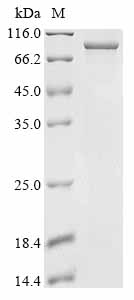Recombinant Human Cullin-3 (CUL3) comes from E. coli expression and contains the complete mature protein sequence from amino acids 2 to 768. The protein includes a C-terminal 6xHis tag that makes purification and detection more straightforward. SDS-PAGE analysis shows purity levels above 85%, which appears suitable for most biochemical experiments. This research-grade protein maintains low endotoxin contamination.
Cullin-3 (CUL3) serves as a central scaffold protein within E3 ubiquitin ligase complexes, making it essential to the ubiquitin-proteasome system. These complexes control protein degradation patterns, which in turn influence cell cycle timing and signal transduction networks. CUL3 has drawn considerable research attention because it helps maintain cellular balance and participates in multiple signaling cascades.
Potential Applications
Note: The applications listed below are based on what we know about this protein's biological functions, published research, and experience from experts in the field. However, we haven't fully tested all of these applications ourselves yet. We'd recommend running some preliminary tests first to make sure they work for your specific research goals.
Based on the provided information, the recombinant human CUL3 is expressed in E. coli, a prokaryotic system that is generally unsuitable for producing functional eukaryotic ubiquitin ligase components. CUL3 is a complex scaffold protein that requires precise folding, neddylation modification, and proper assembly with RING proteins and substrate adaptors for its E3 ubiquitin ligase activity. While the protein is full-length mature (2-768aa) with a C-terminal 6xHis tag and >85% purity, E. coli lacks the eukaryotic chaperones, neddylation machinery, and post-translational modification systems necessary for proper CUL3 function. The C-terminal His-tag may interfere with the native protein structure, particularly the C-terminal domain, which is critical for ubiquitin ligase complex assembly. Since activity is unverified, the protein cannot be assumed to be correctly folded or bioactive without experimental validation of its ability to form functional E3 ligase complexes.
1. Protein-Protein Interaction Studies with BTB Domain-Containing Substrate Adaptors
The C-terminal 6xHis tag enables technical feasibility for interaction studies, but if CUL3 is misfolded (as likely in E. coli), it will not interact physiologically with true binding partners (e.g., BTB domain proteins like KEAP1, SPOP). CUL3 requires precise conformation and neddylation for proper adaptor binding. Identified interactions could be non-physiological artifacts. This application should not be pursued without confirmation of proper folding and neddylation capability.
2. Antibody Development and Validation
The recombinant CUL3 can serve as an effective immunogen for generating antibodies that recognize linear epitopes, even if the recombinant CUL3 protein is misfolded. The full-length sequence ensures broad epitope coverage. However, antibodies may not recognize conformational or neddylation-dependent epitopes of native, properly modified CUL3 in human cells. Validation against endogenous CUL3 from mammalian systems is essential.
3. Biochemical Characterization and Stability Studies
This application is well-suited for assessing the recombinant human CUL3 protein itself. Techniques like analytical ultracentrifugation, size-exclusion chromatography with multi-angle light scattering, and thermal shift assays can evaluate the protein's folding state, oligomerization, and stability. These studies are valuable even if the recombinant human CUL3 protein is inactive, as they characterize the recombinant product and can inform about its suitability for other applications.
4. Structural Biology Applications Using Tag-Assisted Techniques
This application is high-risk without proper folding validation. While the His-tag enables technical approaches for structural studies, if CUL3 is misfolded, structural data will not reflect biological reality. The 85% purity is insufficient for high-resolution structural biology. Techniques like cryo-EM require homogeneous, properly folded complexes. This application should only be pursued after confirming proper folding, complex formation with binding partners, and achieving higher purity.
Final Recommendation & Action Plan
Given the high probability of misfolding in E. coli for this complex eukaryotic ubiquitin ligase component, we recommend first performing comprehensive validation: 1) Biophysical characterization (analytical ultracentrifugation, circular dichroism) to assess folding quality and oligomeric state; 2) Functional validation of E3 ligase activity through in vitro ubiquitination assays with known substrates and binding partners; 3) Testing neddylation capability using human neddylation machinery. Antibody development can proceed immediately as the safest application. Avoid all functional studies (interactions, structural biology) until proper folding and ligase activity are confirmed. For reliable CUL3 research, obtain the protein from eukaryotic expression systems capable of proper folding and neddylation. Always include appropriate controls, such as known BTB domain proteins and validated ubiquitination substrates, in experiments.






